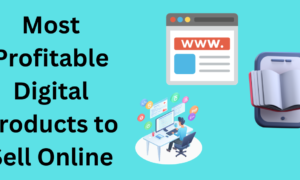Are you struggling to boost your online sales and maximize your profits? In today’s increasingly digital world, mastering the art of online selling is essential for success. Whether you’re an established seller or just starting out, this blog is your ultimate guide to optimizing your online sales in 2024.
From selecting the right products to pricing and shipping strategies, we’ll provide you with practical tips and proven strategies to help you navigate the online marketplace and achieve your sales goals.
Here’s a sneak peek of what you can expect from this comprehensive guide:
1. Choosing the perfect products to sell: Discover how to identify profitable niches and find winning product ideas that will captivate your target audience.
2. Pricing strategies that attract customers: Learn effective pricing techniques to maximize your profits while remaining competitive in the online marketplace.
3. Streamlining your shipping process: Find out how to optimize your shipping operations to provide fast, reliable delivery and enhance the customer experience.
4. Leveraging customer reviews: Understand the importance of customer feedback and learn how to use reviews to build trust and boost your online sales.
Don’t miss out on the opportunity to take your online sales to new heights. Get ready to supercharge your business and achieve your sales targets with these proven strategies.
Introduction to Selling Online
In today’s digital age, online selling has become a vital aspect of business success. With the ability to reach a wider audience and tap into new markets, selling your products online offers numerous benefits. Whether you’re a small business owner looking to expand your customer base or an entrepreneur launching a new venture, the world of e-commerce provides a wealth of opportunities.
One of the key advantages of online selling is the potential to reach customers beyond geographical boundaries. Unlike traditional brick-and-mortar stores, an online business allows you to target customers from all over the world, breaking down the barriers of location. This increased exposure can lead to higher sales and greater profitability.
Moreover, selling online enables you to showcase your products 24/7, providing potential customers with the convenience of browsing and purchasing at their own convenience. The availability of round-the-clock shopping means that you can generate sales even while you sleep, expanding your revenue streams.
Another significant advantage of online selling is the ability to gather valuable data and insights about your customers. Through analytics and tracking tools, you can gain a deeper understanding of your target audience’s preferences, buying behaviors, and demographics. Armed with this information, you can tailor your marketing strategies and product offerings to better resonate with your customers, leading to enhanced sales and customer satisfaction.
Furthermore, online selling allows for greater flexibility and scalability than traditional retail. With the ability to easily add or remove products from your online store, you can quickly adapt to market demands and trends. This agility enables you to stay ahead of competitors and seize lucrative opportunities as they arise.
In summary, online selling presents a wealth of opportunities for businesses of all sizes. By leveraging the power of e-commerce, you can expand your reach, drive sales, and grow your business in the digital marketplace. Stay tuned for the following sections, where we will dive deeper into specific strategies and tips to optimize your online sales.
Figure out what you want to sell
When it comes to selling online, one of the most crucial steps is choosing the right product to sell. This decision will have a significant impact on the success of your online business. Here are some tips to help you figure out what to sell:
1. Research market demand: Conduct thorough market research to identify popular and profitable product categories. Look for products that have a high demand but are not oversaturated in the market.
2. Identify profitable opportunities: Look for niche markets or untapped customer needs that align with your expertise or interests. This will give you a competitive advantage and increase your chances of success.
3. Consider your expertise: Choose a product that you have knowledge and expertise in. This will not only make it easier for you to market and sell the product, but it will also help build trust with your customers.
4. Test and validate: Before committing to a specific product, consider conducting a small-scale test to gauge customer interest and demand. This can help you avoid investing heavily in a product that may not resonate with your target audience.
Remember, the right product is the foundation of a successful online business. Take the time to research, analyze market trends, and identify profitable opportunities to ensure your online venture thrives.
Source products
When it comes to sourcing products for your online business, there are several methods you can consider. One option is manufacturing, where you create your own products from scratch, ensuring full control over quality and customization. Another option is wholesale, where you purchase products in bulk from suppliers and resell them at a markup. Dropshipping is another popular method, where you partner with suppliers who handle the inventory and shipping on your behalf. Regardless of the method you choose, it’s crucial to prioritize quality and reliability. This will help you build trust with your customers and ensure the success of your online business.
Check Listing and Selling Costs
When it comes to selling products online, it’s crucial to research and understand the fees and costs associated with listing and selling on different online platforms. Here are some important points to consider:
1. Platform Fees: Different online platforms have varying fee structures. Research and compare the fees charged for listing products, transaction fees, and any additional charges for premium features or services.
2. Payment Processing Fees: Most platforms charge a percentage or a fixed fee for processing payments. Take into account these fees when determining your pricing strategy.
3. Shipping Costs: Consider the impact of shipping costs on your profit margins. Research shipping rates for different carriers and find the most cost-effective shipping options for your products.
4. International Selling Fees: If you plan to sell internationally, be aware of any additional fees or customs duties that may apply.
5. Subscription Plans: Some platforms offer subscription plans with additional benefits, such as reduced fees or access to advanced selling tools. Evaluate whether these plans align with your business goals.
By understanding these costs upfront, you can make informed decisions about the platforms and pricing strategies that best suit your business. Remember to track and review your expenses regularly to ensure your online selling venture remains profitable.
Remember, the goal of this section is to provide guidance on researching and understanding the fees and costs associated with listing and selling products on different online platforms. Stay focused on providing clear and concise information within the given word count.
Decide how you will handle shipping
When it comes to online selling, choosing the right shipping method and understanding shipping costs are essential. Your shipping strategy plays a crucial role in customer satisfaction and can greatly impact your sales. Here are some tips to help you navigate the shipping process effectively:
Choose the right shipping method
Consider the nature of your products and the preferences of your target audience. Options like standard shipping, expedited shipping, or free shipping can influence customers’ purchasing decisions.
Calculate shipping costs
Take into account factors such as package dimensions, weight, destination, and shipping carrier rates. Utilize shipping calculators to provide accurate cost estimates to your customers.
Set shipping rates
Strike a balance between competitive rates and covering your shipping expenses. Research industry standards and analyze competitors’ shipping practices to determine fair and enticing rates.
Handle returns efficiently
Establish a clear and customer-friendly return policy. Clearly communicate return instructions and ensure hassle-free return processes to build trust with your customers.
Remember, choosing the right shipping method and providing transparent and reliable shipping services contribute to a positive customer experience, which can lead to increased customer satisfaction and repeat business.
Take Good Photos
High-quality product photos play a crucial role in attracting customers and boosting online sales. When shopping online, customers heavily rely on visuals to assess the product’s quality and make purchase decisions. To ensure your product photos are enticing and professional, consider the following tips:
1. Lighting:
– Use natural light or invest in a lighting setup to avoid shadows and enhance clarity.
– Experiment with different angles and positions to achieve the desired effect.
– Avoid harsh lighting that can result in overexposed or washed-out images.
2. Staging:
– Create an appealing backdrop or use props that complement the product.
– Showcase the product’s features and demonstrate its usage, if applicable.
– Ensure that the staging reflects your brand aesthetic and target audience preferences.
3. Editing:
– Enhance the visual appeal of your photos through basic editing techniques.
– Adjust brightness, contrast, and color balance to accurately represent the product.
– Remove any distractions or imperfections that could deter potential customers.
Remember, the goal is to capture your product in the best possible light, conveying its true essence and value. By investing time and effort into taking high-quality photos, you can significantly enhance your online sales and attract more satisfied customers.
Be Descriptive
When it comes to selling products online, the importance of detailed product descriptions cannot be overstated. These descriptions serve as a virtual sales pitch, providing potential customers with accurate information about your products and helping them make informed purchasing decisions. Not only do thorough product descriptions build trust with your customers, but they also set realistic expectations, reducing the likelihood of returns or dissatisfaction.
To create effective product descriptions, highlight the key features and benefits of your products. Use descriptive language that engages your audience and paints a clear picture of what they can expect. Don’t shy away from including specific details such as dimensions, materials used, or special features. Additionally, consider incorporating customer reviews or testimonials to further validate your product’s quality and appeal.
Remember, in the world of online selling, customers rely solely on the information you provide. So, take the time to craft compelling, detailed, and accurate product descriptions that leave no room for uncertainty. By doing so, you’ll not only attract potential customers but also increase the chances of converting them into satisfied buyers.
Here are some tips for creating effective product descriptions:
1. Focus on benefits: Clearly communicate how your product can solve a problem or improve the customer’s life. Highlight the unique features that set it apart from competitors.
2. Use vivid language: Paint a picture in the customer’s mind by using descriptive and engaging language. Help them visualize how your product looks, feels, and works.
3. Address common concerns: Anticipate any potential doubts or questions customers may have and proactively address them in your product description. This demonstrates transparency and builds trust.
4. Keep it concise: While it’s essential to provide detailed information, be mindful of brevity. Use short and impactful sentences to keep the reader engaged.
5. Use bullet points or lists: Break down key features, specifications, or benefits into easy-to-digest bullet points or lists. This helps customers quickly scan the information and grasp the main selling points.
Remember, your product description not only helps customers make purchasing decisions but also optimizes your content for search engines. Include relevant keywords naturally throughout your descriptions to improve your online visibility. By being descriptive and informative, you can make sure that potential customers have all the information they need to confidently make a purchase.
Research the right selling price
Determining the optimal selling price for your products is crucial for online success. Effective price research and analysis can help you find the sweet spot that maximizes sales and profitability. Here are some valuable tips to guide you:
Understand your market
– Research the market demand and competition for similar products.
– Identify pricing patterns and trends within your industry.
– Keep track of pricing strategies used by your competitors.
Consider your costs
– Calculate all costs associated with producing, packaging, and shipping your products.
– Factor in overhead expenses, such as marketing and website maintenance.
– Determine your desired profit margin.
Know your target audience
– Understand the value your products offer to customers.
– Consider the perceived quality and uniqueness of your products.
– Take into account the purchasing power and preferences of your target market.
Offer competitive pricing
– Consider pricing your products slightly lower than your competitors to attract customers.
– Experiment with different pricing strategies, such as discounts and promotions.
– Monitor customer response and adjust pricing accordingly.
Evaluate customer feedback
– Take customer reviews and feedback into account when setting prices.
– Consider adjusting prices based on the perceived value of your products.
– Continuously monitor market trends and adjust your pricing strategy as needed.
By conducting thorough research and analyzing market conditions, you can determine the right selling price that attracts customers and maximizes your sales potential. Remember to periodically review and adjust your prices to stay competitive in the ever-changing online marketplace.
Package items with care
Proper packaging is crucial for ensuring the safety of your products during shipping and delivering a positive customer experience. By taking the time to package your items with care, you can minimize the risk of damage and enhance customer satisfaction. Here are some essential tips for choosing appropriate packaging materials:
1. Select sturdy materials: Use high-quality boxes, bubble wrap, packing peanuts, or air pillows to provide cushioning and protect items from impact.
2. Consider product fragility: If you sell fragile items, opt for protective materials like foam inserts, dividers, or specialized packaging solutions to prevent breakage.
3. Use secure seals: Seal boxes securely with tape or adhesive to prevent any accidental opening during transit.
4. Label clearly: Clearly label fragile items or include special handling instructions to ensure that shipping carriers handle them with care.
5. Take size into account: Choose packaging materials that fit your products snugly to prevent movement and reduce the risk of damage.
6. Customize when necessary: For delicate or irregularly shaped items, consider custom packaging options that provide a perfect fit and additional protection.
Remember, investing in proper packaging not only protects your products but also helps to maintain customer trust and satisfaction. By implementing these tips, you can ensure that your items arrive safely at their destination and leave a lasting positive impression on your customers.
Reach Potential Customers on Social Media
In today’s digital landscape, leveraging social media platforms is essential for reaching potential customers and boosting online sales. Here are some effective social media marketing strategies to help you connect with your target audience:
1. Identify Your Target Audience: Understand who your ideal customers are and which social media platforms they frequent the most. Tailor your content and messaging to resonate with your target demographic.
2. Create Engaging Content: Develop compelling and visually appealing content that is relevant to your audience. Utilize storytelling, visuals, and compelling captions to capture attention and encourage interaction.
3. Build a Strong Brand Presence: Establish a consistent brand presence across your social media profiles. Use your brand’s unique voice, tone, and aesthetics to create a cohesive and recognizable identity.
4. Engage and Interact: Regularly interact with your followers, respond to comments and messages, and actively engage with relevant communities and influencers in your industry. This fosters a sense of community and builds trust with your audience.
5. Use Hashtags Strategically: Research and incorporate relevant hashtags into your posts to increase visibility and reach a wider audience. Don’t forget to create branded hashtags specific to your business or campaigns.
6. Utilize Paid Advertising: Consider investing in social media advertising to reach a larger audience and target specific demographics. Platforms like Facebook and Instagram offer robust ad targeting options to maximize your marketing efforts.
7. Analyze and Optimize: Regularly monitor your social media metrics to assess the effectiveness of your campaigns. Use analytics to identify top-performing content and make data-driven decisions to optimize your social media strategy.
Remember, building a strong social media presence takes time and effort. Consistency, authenticity, and engaging content are key to successfully reaching potential customers and driving online sales.
Selling on Amazon
Selling on Amazon can offer numerous benefits and opportunities for online sellers. With its extensive customer base and global reach, Amazon provides a platform that can significantly boost your online sales. Here’s a brief overview of the benefits and considerations of selling on Amazon, along with an introduction to the Amazon Seller Central platform and its key features.
Benefits of Selling on Amazon
1. Wide Customer Base: Amazon has millions of active users, providing sellers with access to a vast customer base ready to make purchases.
2. Global Reach: With marketplaces in various countries, Amazon offers sellers the opportunity to expand their reach internationally and tap into new markets.
3. Brand Exposure: Selling on Amazon can increase brand visibility and expose your products to a wider audience, helping to build trust and credibility.
4. Fulfillment Options: Amazon’s FBA (Fulfillment by Amazon) program allows sellers to store their inventory in Amazon’s warehouses and utilize their efficient fulfillment services, including picking, packing, and shipping.
Considerations for Selling on Amazon
1. Competition: Amazon is a highly competitive marketplace, so it’s essential to differentiate your products and optimize your listings to stand out from the crowd.
2. Fees and Costs: Selling on Amazon involves various fees, including referral fees, fulfillment fees, and subscription fees for professional accounts. Sellers need to carefully evaluate and plan their pricing strategies to ensure profitability.
3. Inventory Management: Efficient inventory management is crucial on Amazon to avoid stockouts or overselling. Regularly monitoring inventory levels and utilizing Amazon’s inventory tools can help maintain product availability.
Amazon Seller Central Platform
Amazon Seller Central is the platform that allows sellers to manage their Amazon accounts. It provides a range of tools and features to streamline the selling process, including:
1. Product Listing: Sellers can create and manage product listings, including adding images, descriptions, and specifications.
2. Inventory Management: The platform enables sellers to monitor and track their inventory levels, set up automated replenishment, and manage product variations.
3. Order Management: Sellers can easily process and fulfill orders, access order details, print shipping labels, and track shipments.
4. Performance Analytics: Amazon Seller Central provides detailed analytics and reporting to help sellers monitor sales performance, track customer satisfaction, and identify areas for improvement.
In conclusion, selling on Amazon offers significant advantages in terms of reaching a wide customer base, global exposure, and leveraging Amazon’s fulfillment capabilities. However, sellers must weigh the competition and consider the associated fees, while utilizing the features and tools available in Amazon Seller Central to enhance their selling experience.
FAQs about Selling Online
Here are some frequently asked questions related to online selling, covering topics such as setting up an online store, managing inventory, and handling customer service.
How do I set up an online store?
Setting up an online store involves several steps. First, you’ll need to choose an eCommerce platform or marketplace that suits your needs, such as Shopify or WooCommerce. Then, you’ll need to select a domain name, design your store, and add your products. Finally, you’ll need to set up payment and shipping options to ensure a smooth buying experience for your customers.
How can I manage inventory effectively?
Inventory management is crucial for smooth operations. You can use inventory management software to track stock levels, set up automated alerts for low stock, and streamline the process of restocking. It’s essential to regularly monitor inventory, especially during peak seasons, to avoid stockouts and delays in fulfilling orders.
What can I do to provide excellent customer service?
Customer service is a key aspect of successful online selling. Promptly respond to customer inquiries and address any concerns or issues they may have. Offer multiple channels for customer communication, such as email, phone, and live chat. Providing clear and helpful information about your products, shipping policies, and returns/exchanges can also contribute to a positive customer experience.
How can I optimize product listings for better visibility?
To optimize your product listings, focus on writing engaging and informative descriptions that highlight the features and benefits of your products. Use relevant keywords in your titles and descriptions to improve visibility in search results. Including high-quality product images from different angles and providing accurate product dimensions and specifications can also enhance the overall shopping experience for potential buyers.
How do I handle shipping and fulfillment?
When it comes to shipping, you have options. You can fulfill orders in-house, work with a fulfillment center, or use dropshipping services. Calculate shipping costs based on factors like package weight, dimensions, and destination. Consider offering free shipping promotions to attract customers. Keep track of shipments and provide tracking information to buyers for transparency and peace of mind.
Remember, these FAQs are just a starting point. As you delve into the world of online selling, continue to research and stay updated on industry best practices to ensure your success.





















